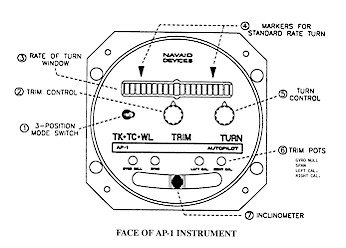
I think one of the best things I did early on back in the tail section was begin to think about the panel. The major problem with me was I was very concerned about my ability to pay for the panel when the time came. You see there is a major outlay of money at reletively the same time. The Engine, prop, and avionics get purchased around the same time and they are the bulk of the airplanes costs. What I didn't want to have happen was to skimp on engine and prop to buy avionics due to the timing of it all. So I started early on purchasing those things I knew i had to have, and some things I just wanted. The key here was to spread the costs out over time as to not get slammed with the costs at a time when the largest purchase, the engine and prop, was to occur. The only item I held off on was the NAV/COM/GPS units. I was not sure what I wanted and the technology was moving to fast for me to jump in.
First item was the NAVAID autopilot. The head unit (sits in the panel) also doubles for your turn/bank coordinator. It is a very nice electric gyro system. There are several in planes in my local EAA chapter and I was able to get good reviews of it. Also the servo unit is easier to install while building the wings to it made sense to get it early on.

Santa Clause 99 got me an Altimeter, Vertical Speed Indicator, and a key switch. All purchased from Wagaero.
Next came the spring of 2000, still working on the wings, where I kept close eyes on E-bay auctions. There are a ton of aviation items in there, and a ton of crap as well. After months of monitoring sellers and bidders, I was able to snag a VOR head for $20, a new in box Sigma Tek Attitude indicator (vacuum) $429, and a Directional Gyro new $329.
Next items were the engine monitoring devices. Federal Aviation Regulations part 91 lays out what you need for both VFR, and IFR flight. I had been eyeing the Rocky Mountain Instruments all digital engine monitoring device. What I liked was the all in one unit, and more importantly, audible alarms for out of range elements. I can't tell you how many stories I have heard and read of engine problems that could have been avoided had the pilot been alerted to the problem early on. High cylinder head temps, low oil pressure or whatever. Most Cessna type aircraft have gages, but if your not staring at them always, it does not take to long for an item to get out of range and before you realize it, boom your engine is dead. So I got this unit. Also several folks in the area have this unit and swear by it. The cost is a bit high, around $1600 for all the sensors. But I plan on feeling safe, and being relaxed in the cockpit and this unit will help me do that. The only down side I can see is that this is a single point of failure. Meaning should I loose electrical power, I'm out all engine gages. The standard analog gages do not have this weakness.
last updated 11/05/2002